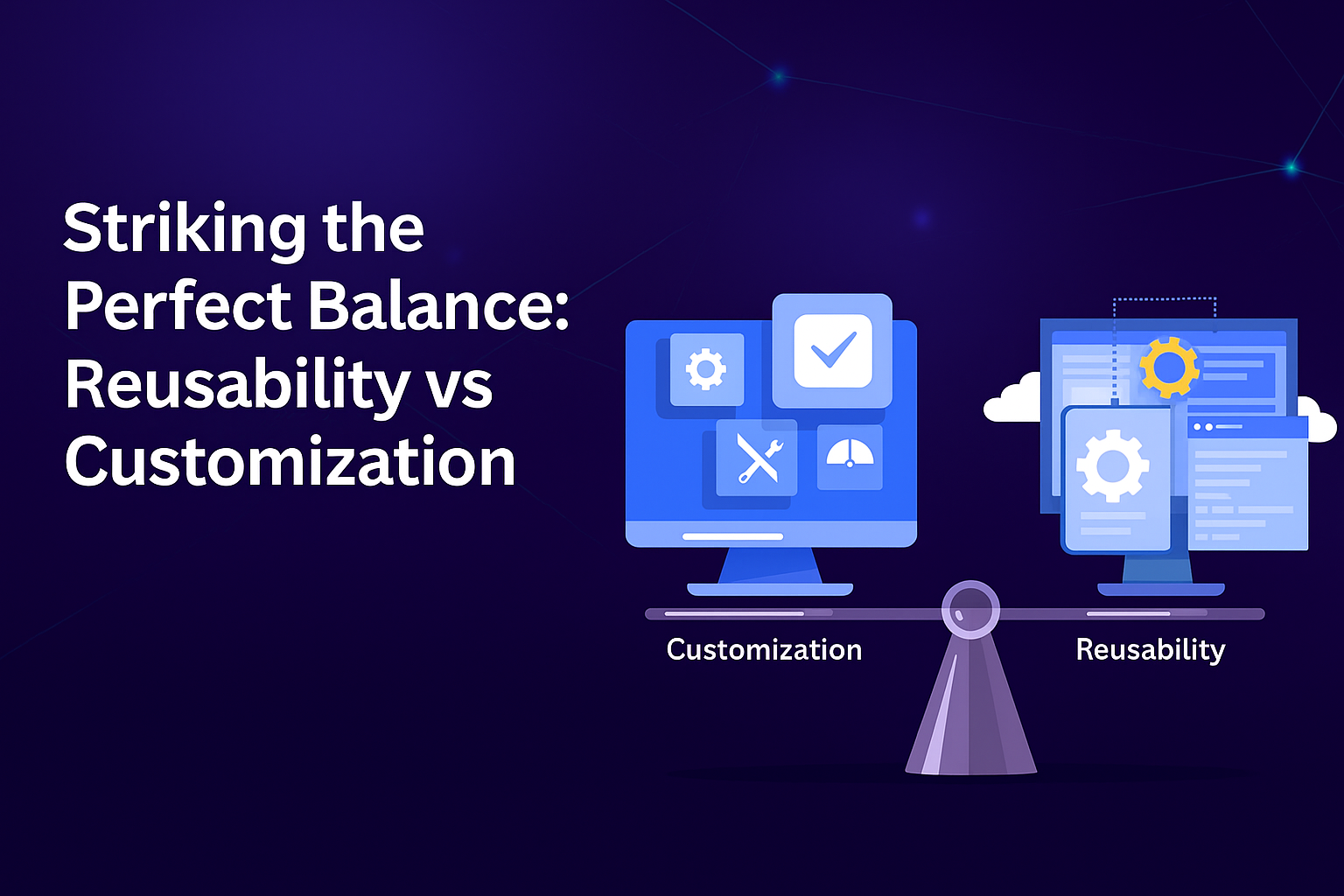Introduction
In today’s hyper-competitive, ever-evolving tech world, product development teams constantly juggle two seemingly opposite priorities: reusability and customization. One promises speed and efficiency, the other delivers unique, tailored experiences. Striking the right balance between the two is like walking a tightrope — too much weight on one side can topple your entire product strategy.
So, how do you walk that tightrope confidently? Let’s dive deep and decode this balancing act.
Understanding the Core Concepts
What is Reusability?
Reusability is all about building components, modules, or code that can be used across multiple projects or products without significant changes. Think of it as having a set of Lego blocks that can be reassembled into different models depending on the need.
What is Customization?
Customization focuses on creating tailored solutions to meet specific user needs. Instead of using one-size-fits-all components, you design features, interfaces, and workflows that cater directly to unique requirements.
How These Approaches Differ
While reusability emphasizes efficiency and scalability, customization aims for uniqueness and personal connection with the user. Both have their place — but they serve very different masters.
The Benefits of Reusability
Faster Development Cycles
Reusable components save massive development time. Once a module is built, tested, and optimized, it can be easily plugged into new projects, slashing time-to-market.
Cost-Efficiency
Less development effort means lower costs. Your team isn’t reinventing the wheel every time, which translates into significant financial savings, especially in large-scale organizations.
Consistency Across Products
Reusability ensures consistency in user experience, design language, and performance, which is crucial for brand identity and customer trust.
Easier Maintenance and Scalability
Fix a bug once, and it’s fixed everywhere. Updates and upgrades become far simpler, as shared components allow for centralized maintenance.
The Drawbacks of Reusability
Limited Flexibility
Reusable components may not fit every unique business scenario. Trying to force them into incompatible projects can lead to subpar user experiences.
Stifled Innovation
Over-reliance on existing components may discourage teams from experimenting with fresh ideas or breakthrough innovations.
Potential Technical Debt
Without strict governance, reusable components can accumulate patches and exceptions, becoming bloated and hard to maintain over time.
The Benefits of Customization
Tailored User Experiences
Customization lets you build exactly what your users need, enhancing satisfaction and loyalty. You’re addressing pain points directly rather than hoping general solutions suffice.
Competitive Differentiation
In crowded markets, unique features can set you apart. Customization allows brands to differentiate their offerings from cookie-cutter solutions.
Enhanced Customer Satisfaction
When users feel like a product was made just for them, satisfaction and engagement soar. This often translates into higher retention and lifetime value.
Adaptability to Niche Markets
Customization enables businesses to target very specific market segments, capturing audiences that broad, generic solutions might miss.
The Drawbacks of Customization
Higher Development Costs
Tailoring solutions requires more time, expertise, and money. Each custom element adds to development and testing efforts.
Longer Time-to-Market
Creating something unique naturally takes longer. The more you customize, the longer it may take to reach your launch date.
Maintenance Complexity
Every unique feature introduces more complexity, making future updates, integrations, and support increasingly complicated.
Risk of Over-Engineering
Without clear boundaries, customization can spiral into unnecessary complexity, bloating your product and confusing users.
Key Factors to Consider Before Choosing an Approach
Target Audience Needs
Who are your users? Are they looking for highly specialized solutions or broadly applicable tools?
Market Dynamics
Are you entering a highly competitive market where differentiation is key? Or is speed and efficiency your primary concern?
Budget and Resource Availability
Do you have the financial and human resources to sustain heavy customization? Or does your budget favor reusable, scalable components?
Long-Term Business Goals
Are you building a short-term solution or a long-lasting platform? Reusability often supports long-term sustainability.
Technological Capabilities
Your team’s expertise may also influence your approach. Some technologies lend themselves better to modular, reusable designs, while others facilitate customization.
When to Prioritize Reusability
Scenarios Favoring Reusable Components
- SaaS platforms serving multiple industries
- Internal enterprise tools used across departments
- Multi-brand product lines with shared core functionality
Industries Where Reusability Excels
- Fintech (payment processing, security modules)
- Healthcare (compliance, data privacy frameworks)
- E-commerce (shopping carts, inventory systems)
Examples of Successful Reusable Models
- Google Cloud: Offers modular services that businesses can mix and match.
- WordPress: Highly reusable themes and plugins power millions of websites.
When to Prioritize Customization
Scenarios Requiring Unique Solutions
- Specialized industry software
- High-end consumer products with exclusive features
- Projects demanding unique user interfaces
Industries Where Customization is Critical
- Luxury goods and services
- Professional services (legal, healthcare diagnostics)
- Custom manufacturing
Examples of Customized Product Success Stories
- Salesforce CRM: Highly customizable to fit various business needs.
- Tesla Vehicles: Custom software and hardware integration for unique driving experiences.
Hybrid Approach: The Best of Both Worlds
Modular Design Strategies
Build flexible modules that can be reused but still allow easy configuration to meet specific needs.
Configurable Frameworks
Develop core systems that offer configuration options without extensive redevelopment.
Microservices and API-Driven Architecture
Using independent, loosely coupled services allows you to reuse core functions while customizing client-facing features.
Case Studies of Companies Adopting Hybrid Models
- Shopify: Core e-commerce features with highly customizable storefronts.
- Microsoft Azure: Core cloud services with options for tailored solutions.
The Role of Agile and DevOps in Balancing Both
Agile Practices Enabling Flexibility
Agile’s iterative approach allows teams to experiment with customization while retaining reusable structures.
DevOps Promoting Reusability and Continuous Delivery
Automation and CI/CD pipelines streamline deployment of reusable components, while allowing custom features to be integrated seamlessly.
Emerging Technologies Influencing the Balance
AI and Machine Learning in Product Customization
AI enables hyper-personalized features like recommendation engines, chatbots, and predictive analytics.
Low-Code/No-Code Platforms Enhancing Reusability
Citizen developers can build on pre-configured modules, allowing for faster deployment with limited customization.
Cloud-Native Development and Its Dual Advantages
Cloud-native architecture supports scalability (reusability) and modular customization simultaneously.
Common Mistakes to Avoid
Over-Engineering Reusable Components
Trying to cover every possible scenario can make reusable modules bloated and hard to maintain.
Over-Customizing to the Point of Inefficiency
Every minor customization adds complexity; focus on features that deliver real user value.
Ignoring User Feedback
Whether reusing or customizing, user feedback should always guide your development priorities.
Future Trends in Product Development Approaches
Hyper-Personalization vs. Universal Platforms
AI-driven personalization will push customization further, while platforms like Shopify and AWS demonstrate the power of universal, highly reusable services.
The Rise of Composable Architecture
Composable architecture offers ultimate flexibility by allowing teams to assemble their tech stack like building blocks, mixing reusable and custom components seamlessly.
Conclusion
There’s no one-size-fits-all solution when it comes to balancing reusability and customization. The smartest teams evaluate their goals, users, and resources to create a development strategy that combines speed, cost-effectiveness, and unique value.
Reusability gives you the efficiency to scale; customization gives you the edge to compete. The real magic happens when you blend the two intelligently.
FAQs
1. Can I start with reusable components and add customization later?
Absolutely! Many companies build a reusable core first and then layer in custom features as their business grows or customer needs evolve.
2. Does customization always mean higher costs?
Not necessarily. Thoughtful customization that targets critical user needs can deliver excellent ROI. The key is avoiding unnecessary complexity.
3. What industries benefit most from reusability?
Industries with standardized processes — like fintech, healthcare, and e-commerce — often benefit the most from reusability.
4. How does cloud-native development support both approaches?
Cloud-native design allows modular services, making it easier to reuse core functions while customizing specific features or experiences.
5. Is hybrid development suitable for startups?
Yes! Startups can leverage reusable frameworks for speed while adding just enough customization to stand out in the market.







